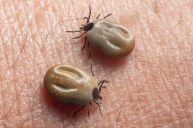What is Anaplasmosis in dogs, and how can it be prevented?
While Lyme disease may be the first tick-borne illness that comes to mind, others can affect your furry friend. Anaplasmosis is a tick-borne bacterial disease that infects the bloodstream of dogs and humans. There are two strains; The most prevalent type of the disease, Anaplasma phagocytophilum, is spread through deer tick bites and infects white blood cells. The second strain is called Anaplasma platys. Borne by the brown dog tick, this strain attacks platelets and blood-clotting cells.
Anaplasmosis is common in the United States and Canada, especially in the Gulf states, California, and the upper Midwest, North East, Mid-Atlantic, and Southwest regions where transmitting species of ticks thrive. Some dogs may also contract Ehrlichiosis, another form of Anaplasmosis, which is transmitted by a different strain. Ehrlichia canis is the most common pathogen involved in the transmission of Ehrlichiosis, though several other species can cause it as well. Humans are also susceptible to contracting what's called Human Granulocytic Ehrlichiosis, as well as many other forms of tick-borne illness.
Symptoms of Anaplasmosis in Dogs
https://www.instagram.com/p/B0jBukEhisY/
The signs of Anaplasmosis differ depending on the strain. The clinical signs of A phagocytophilum will appear anytime between one and seven days. Symptoms can include fever, lethargy, lack of appetite, malaise, joint pain, lameness, vomiting, anemia, coughing, labored breathing, seizures, and loss of muscle movement control (ataxia). Some infected dogs may only exhibit minor symptoms, while other dogs can present more serious ones. Dogs infected with A. platys will develop bruising and bleeding due to a decrease in blood-clotting platelets. Low platelet counts may lead to general lethargy in your dog, long before they become sick enough to be noticeable. Nosebleeds are often the first noticeable sign of an infection.
How Anaplasmosis Is Diagnosed
If you notice symptoms of Anaplasmosis, Lyme disease, or Ehrlichiosis in your pet, take them to your vet immediately. Sometimes these illnesses can coexist as they are transmitted by the same species of tick. Your vet may order blood tests, antibody tests, and other forms of serology to determine both the antibody and whether there is an active infection, or view the bacterial organism under a microscope. Other tests include enzyme-linked immunosorbent assay (ELISA), polymerase chain reaction (PCR), and indirect fluorescent antibody (IFA).
How Anaplasmosis Is Treated
https://www.instagram.com/p/Bzs7dexBv4V/
Vets may prescribe a course of doxycycline or tetracycline to dogs that test positive for canine Anaplasmosis. These are the same antibiotics that are used to treat other tick-borne illnesses and will also treat co-infections. Your dog should start to show improvement with 1-2 days of starting treatment, but make sure you finish their entire 30-day course of antibiotics, and report any abnormalities to your DVM. Dogs may still have a positive test result even after they have finished their antibiotics and stopped showing signs of clinical disease. If this is the case, your vet will likely not prescribe another course of antibiotics.
How Can You Prevent Anaplasmosis?
Retrievers and other dogs love to play in tall grass, but these areas are often the easiest place to contract a tick-borne illness. Fortunately, you can keep your own neck of the woods safe with a few strategies. Tick prevention is the best way to prevent Anaplasmosis or any other tick-borne disease. Your veterinarian may prescribe topical, oral, or portable tick repellents to keep ticks away from your dog while outdoors. Medicated shampoos can be used to kill ticks on touch. Tick dips, which you apply to your dog, contain concentrated chemicals that destroy ticks and can be used when you've gone through a tick infested area. Make sure to trim bushes and trees and keep lawns mowed to limit infected tick exposure for your animals if you live in an endemic area.
If ticks are still a problem in your yard, use anti-tick sprays and granular therapies for tick control. Ticks can be found between toes, inside the ears, between the legs, and deep inside coats, so make sure to check your dog (and yourself) thoroughly when returning from an outing outdoors. It just may save a life.
Share your experience on the Wide Open Pets Facebook page!




